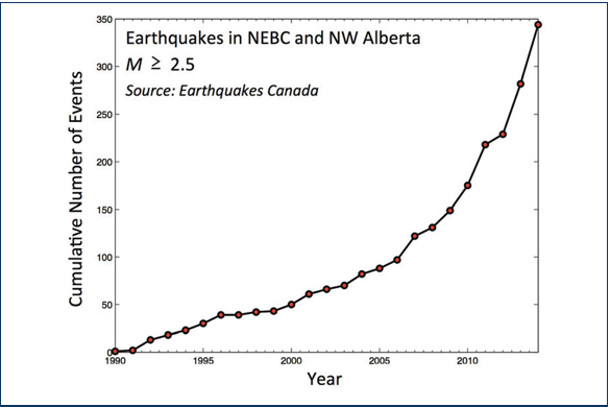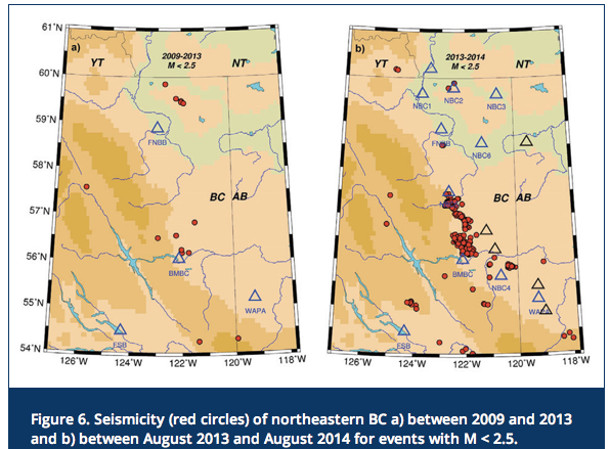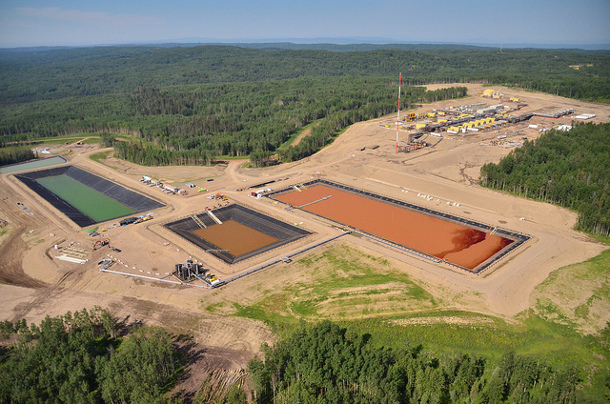New research and presentations by both provincial and federal scientists show that the shale gas industry, which the B.C. government hopes will eventually supply proposed liquefied natural gas terminals with fracked gas, has caused more than a thousand earthquakes in northeast B.C. since 2006 and changed the region's seismicity.
The earthquakes, ranging in magnitude from 1.0 to 4.3, include six events higher than 4.0 and more than 20 events that shook buildings and moved furniture in places like Fort St. John. Several events caused casing damage to horizontal wells. Moreover, industry-caused tremors remain an ongoing geological revolution for the region.
Earthquakes with a magnitude of about 2.0 or less are called microquakes and can't be felt at the surface. Events above 3.0 can be felt on the ground, and tremors just larger than 4.0 can cause minor damage. A great earthquake, capable of extensive damage, typically measures a magnitude of 8.0.
Scientists once thought that hydraulic fracturing wouldn't trigger anything more than microquakes. But now that the technology has set off magnitude 4.4 quakes in Alberta, scientists are grappling to determine what kind of hazard industrial tremors might pose to pipelines, dams and other infrastructure.
At Upper Halfway, a community northeast of Fort St. John, residents have described the tremors as a series of crashes and bangs comparable to someone driving "a truck into the side of the house."
The shale gas industry involves the injection of highly pressurized fluids into wells to crack open difficult oil and gas deposits. The injections create a network of cracks that can also connect to fault zones. The reactivation of these faults can then trigger an earthquake, scientists say.
Due to limited monitoring, industry and government lack a full understanding of how the wave of quakes is changing the flow of groundwater in the region or the migration of gases such as methane, radon and carbon dioxide into the atmosphere throughout northeast B.C.
Earthquakes triggered by the shale gas industry in B.C. have not injured anybody or damaged public property to date. But industry-made tremors in the U.S. Midwest have caused damage in Oklahoma and created new insurance liabilities.
The United States Geological Survey concedes that "the most probable risks in areas of increased seismicity include life-threatening injuries caused by falling objects and economic loss from damage to structures with low capacity to absorb moderate earthquake shaking... there is no question that increased hazard accompanies higher levels of earthquake activity."
A recent presentation by Dan Walker, senior petroleum geologist for the BC Oil and Gas Commission, identified public safety, property damage, well bore integrity (the shaking can cause wells to leak methane) and aquifer contamination as genuine hazards from industry quakes.
But the BC Oil and Gas Commission would not grant the Tyee an interview with Walker to discuss his presentation in detail.
Walker gave another presentation on lessons learned from the industry-triggered earthquakes in B.C. at a 2015 Montreal meeting of the American Geophysical Union.
At that meeting, he said that controlling earthquakes caused by wastewater disposal wells was easier than managing tremors set off from fluid injection from hydraulic fracturing. There are more than 100 wastewater injection sites in northern B.C.
At disposal wells, the Commission can reduce rates of fluid injection or find alternative disposal zones with no faults nearby, Walker wrote in an abstract of his talk.

But hydraulic fracturing blasts fluids at much higher pressure into the ground and "responding immediately to hydraulic fracture induced events is limited to avoiding known active faults, altering hydraulic fracture parameters or suspending operations."
In addition to the need for comprehensive seismic monitoring and event reporting, Walker said one of the key lessons learned to date was that "areas considered to be high risk for inducted seismicity should be considered for exclusion from development."
In a series of emails to The Tyee, the Commission said this lesson was not part of its policy and that the agency, which is funded by industry, would "respond to events as they occur and take measures to protect the public and environment."
Many scientific uncertainties
Scientists are now concerned that industry's potential to trigger unplanned seismic events has increased significantly with hydraulic fracturing and water well injection, because critically stressed faults can exist nearly anywhere.
In addition, teams of scientists studying the issue in western Canada admit that they are dealing with much uncertainty because the shaking hazards caused by industry-triggered tremors can be greater than those from natural earthquakes.
University of Western Ontario seismic hazard expert Gail Atkinson, the leader of a research effort called the Canadian Induced Seismicity Collaboration, explained that researchers "cannot predict the likelihood or magnitude of such events from specific planned operations because we do not have enough data on the complex natural rock systems, nor do we have validated predictive models."
Nor do scientists know if industry-triggered events can change fluid and gas flows in the earth the same way that natural earthquakes can.
Earth scientists, for example, have long observed that the energy released from natural earthquakes can force dramatic changes in groundwater flow, levels and quality. At the same time, the shaking motion caused by earthquakes can also release a variety of gases through newly formed faults and fractures in the ground.
According to one industry textbook on the subject of gas migration, seismic activity can form "vertical and subvertical faults and fractures above petroleum reservoirs." As a result, the increased upward migration of radon, hydrogen sulphide, methane and carbon dioxide in seismically active areas "can become a major environmental hazard."
Despite research in Australia showing high levels of methane, radon and CO2 escaping from fracked landscapes into the atmosphere, no such monitoring is taking place in either Alberta or B.C.
Once quiet, now seismically active
Although recent B.C. research sheds little insight on the impacts on groundwater and gas migration, it does show that the injection of highly pressurized fluids from hydraulic fracturing or wastewater disposal at depths of two kilometres can change pressure and trigger fault activity -- sometimes months after the blasting of fluids underground.
The research began in 2012 after hundreds of mini-quakes were recorded in the Horn River basin. To get a handle on the growing problem, federal and provincial researchers have since installed eight more seismograph stations in northern B.C. to capture the ground shaking.
A June 2015 study published in The Leading Edge reported that hydraulic fracturing had turned a quiet seismic area into a highly active one. The paper concluded that "the level of local seismicity in the shale gas production area clearly has increased, both in number of events and in magnitude, as the scale of hydraulic fracturing operations expanded from late 2006 through 2011."
John Cassidy, a Natural Resource Canada seismologist and one of the paper's researchers, explained that the Horn River basin experienced some small natural tremors prior to hydraulic fracturing, but none in the shale gas zone.

However, the introduction of fracking, which can pump down 25 million gallons of water into one horizontal well in the Horn River basin, changed local seismic patterns.
The study also found that a higher volume of injected fluid (more than a million gallons a month) was a necessary "but not sufficient condition to induce larger earthquakes."
In other words, large blasts of fluid into the ground only caused earthquakes in some places and at some times, perhaps due to pre-existing faults or background stress in the ground.
"There is something else involved there and what it is -- that's our focus. There appears to be a time delay in some cases, and we don't know exactly what's controlling that," Cassidy said.
How frequent and how large the earthquakes can get is also part of the ongoing research.
Meanwhile, the shaking has not stopped in the most active drilling area, the Montney Shale basin, a large swath of land stretching from northeast B.C. to northwest Alberta. Since the start of 2015, Natural Resources Canada recorded more than 79 earthquakes: seven exceeded magnitude 2.0. The BC Oil and Gas Commission estimates that the injection of wastewater produced from shale gas wells triggered at least 16 of the quakes.
The B.C. research mirrors to a degree what's happening in Oklahoma, where the shale gas industry has made the state more seismically active than California.
Last June, a Science paper concluded that injection wells shooting the most wastewater into the ground -- more than 300,000 barrels a month -- were more likely to be linked to earthquakes throughout Oklahoma.
In particular, researchers linked four of Oklahoma's most prolific wastewater wells, which injected a total of three million barrels of salt water a month into the ground at depths between two and five kilometres, to a swarm of 2,547 small earthquakes near Jones, Oklahoma.
In contrast, high-volume hydraulic fracturing has caused the majority of B.C.'s industry-triggered quakes.
Groundwater monitoring inadequate: scientists
To date, the BC Oil and Gas Commission says "there have been no cases of aquifer contamination resulting from induced seismicity."
But hydrogeologists argue that the province's seven groundwater observation wells for an immense geography punctured by 8,000 high-volume, fractured horizontal wells is inadequate to the task at hand. (The Ministry of Environment collects samples from the wells periodically and tests for certain chemicals.)
"It is ridiculous for the B.C. government to refer to the seven shallow wells in that area or any other area as a 'groundwater observation network,'" said John Cherry, one of the nation's top groundwater researchers.
Groundwater systems are so complex that proper monitoring requires scores of stations with many wells at different depths depending on the local geology, Cherry said.
Gilles Wendling, a 55-year hydrogeologist with extensive experience in northern B.C., described groundwater resources in the region as an irreplaceable treasure. The province would need a multimillion-dollar groundwater monitoring network, he said, to demonstrate that neither hydraulic fracturing nor related earthquake activity have contaminated aquifers with hydrocarbons.
"It's not being required, so why would industry do it?" Wendling asked.
Moreover, industry-caused quakes pose a definite risk to groundwater, he said. "There is a chance industry-made earthquakes can create pathways for fluids, gas or liquids to move underground. They will move from the area where pressure is highest to the lowest... The migration will be upwards."
Neither industry nor citizens appreciate the importance and complexity of groundwater movement, he said. "The general public sees the subsurface as an inert place where there is no life, and if it's fractured, so what? The fact that there is a moving system of fluids 2,000 metres under our feet -- they can't visualize that."
Texas researchers have reported groundwater contamination with hydrocarbons overlying the Barnett Shale region.
Risk to dams?
The importance of extensive earthquake monitoring in shale gas regions was recently underscored by Gail Atkinson and other researchers in a recent paper for Seismological Research Letters.
Atkinson's team looked at three significant earthquakes set off by oil and gas industry: two magnitude 4.0 events near Fort St. John triggered by hydraulic fracturing, and one 3.5 event near Rocky Mountain House possibly set off by wastewater disposal or gas extraction.
The seismic hazard expert concluded "that moderate-induced events may be damaging to nearby infrastructure, because the shallow focal depth may result in localized strong ground motions to which some infrastructure may be vulnerable; this is a particular concern in low-to-moderate seismicity regions, because seismic design measures for structures in these regions may be minimal."
As a consequence, the earthquakes have caught the attention of BC Hydro, which operates and maintains 79 dams at 41 sites across British Columbia.
Steven Rigby, chief of dam safety for BC Hydro, said in an email that the utility has been in discussion with the BC Oil and Gas Commission for a while on this issue. "Nothing official as yet, but certainly we'll be notified in advance of any new proposed licensing activity anywhere near our facilities, or any planned activity on existing licenses, so as to ensure the necessary discussions take place prior to any work."
The U.S. Army Corps of Engineers has expressed a number of concerns with hydraulic fracturing. The agency says industry-triggered earthquakes could crack a dam, and that the transmission of frack fluids through natural faults could erode a dam's embankment.
Industry-made fractures in rock cannot always be controlled and tend to find the path of least resistance. Since 2010, hydraulic fractures have "communicated" with neighbouring well sites and drilling pads in northern B.C. more than 107 times. ![]()
Read more: Energy, Politics, Labour + Industry, Environment

















Tyee Commenting Guidelines
Comments that violate guidelines risk being deleted, and violations may result in a temporary or permanent user ban. Maintain the spirit of good conversation to stay in the discussion.
*Please note The Tyee is not a forum for spreading misinformation about COVID-19, denying its existence or minimizing its risk to public health.
Do:
Do not: